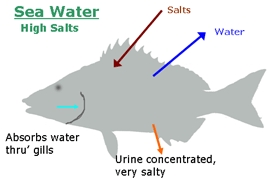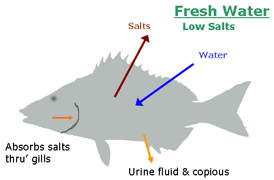|
Eco Bites |
 |
|
Estuarine Fish |
 |
|
Estuaries are extremely
productive systems, in
productivity it ranks right up
there with coral reefs and
tropical forests as the most
productive of natural ecosystems
(see article on
Productivity in Estuaries). Yet, it is also
a very harsh environment with
conditions less than optimal for
either plant or animal species. |
|
Some of the factors that contribute to this harsh
environment are the following: |
|
• |
Salinity variations – at any one point in the mid
region of an estuary, this can change from virtually
completely fresh water to seawater over a period of
six hours. |
|
• |
Temperature variations – shallow waters can heat up
to the surrounding air temperature on a hot day, but
deeper waters remain cool. Cooler or warmer water
can also flow in from the sea during tidal action or
from the river. |
|
• |
Oxygen level variations – levels of oxygen in the
water also vary considerably. Where eutrophication
is taking place it can drop right down, eg in salt
marshes and in deeper water areas. Right next to
such an area in the mainstream of the estuary the
oxygen levels can be normal. |
|
• |
Tidal currents – tidal currents changing direction
every six hours mean that pelagic animals (ie
free-swimming animals) are
continuously swept up and down the estuary; and
have to spend a lot of energy on trying not to be
swept out to sea or too far up the estuary. |
|
Plants and animals normally seek a reasonably stable
environment to establish themselves. They do not
like extreme fluctuations in environmental
conditions, and where this does occur would usually
take evasive action to keep their own immediate
environment as stable as possible (eg animals in the
desert will usuallly burrow underground to escape
the extreme heat of the day). Yet, in spite of
extreme fluctuations in several environmental
conditions, the high productivity in an estuary is
a major attraction to plants and animals. We thus
find that although an estuary have relatively few
species living there, these often occur in very
large numbers. |
 |
|
Our estuaries are popular
fishing spots, but have you
considered how these fish
species have managed to adapt to
these harsh conditions and even
thrive. |
|
All fish living in estuaries are
of marine origin. Most breed out
at sea, but a few (like sea
horses and some smaller klipfish
species) may also breed in the
estuary if the conditions are
right. Some species can live
their whole life-cycle in the
estuary, but these were
originally marine species that
have adapted over time. There
are some freshwater species (eg
salmon and trout) which migrate
through an estuary to the sea,
but they are not typical
estuarine species, even though
they have the same physiological
adaptations. |
|
Fish species found in estuaries
fall into one of two categories: |
|
• |
Opportunistic – these use the
estuary for protection and
feeding during the juvenile
stages (as a nursery), and some
adult species will make use of
the highly productive estuary
for feeding purposes. Sometimes
we find that older and larger
fish may make the estuary a more
or less permanent home (eg
kabeljou), probably as
protection from large predators
at sea (sharks). With
opportunistic users it is
usually only a relatively small
proportion of the total
population that actually enters
an estuary. |
|
• |
Essential – some species have an
essential estuarine phase, which
means that a major proportion of
the population will enter
estuaries at some stage of its
life-cycle. One
well-known example is the
so-called freshwater eel, which
is actually of marine origin, but spends
most of its adult life in
freshwater; however it must
return to its breeding grounds
in the sea to reproduce. It is
also thought that some species
like steenbras (and possibly
other species in that group)
must have an estuarine phase to
become sexually mature. |
 |
|
The extreme conditions means
that life is not easy for a fish
in the estuary, the most
important physiological
adaptation is to be able to
adapt to salinity changes. |
|
The body fluids of a fish has
salt and mineral content lower
than sea water – this means that
in the sea a fish will actually
lose water and tend to
dehydrate. To compensate the
fish extracts the salt from the
water it swallows and excretes
it in highly concentrated urine
– in the process retaining water
in its body. |

 |
|
In fresh water the biogenic salt
content is higher than the
surrounding water – this means
that water will tend to enter
the fish’s body and make it
swell up and burst! Here
the fish must extract as much
salts from the water as possible
and retain it in its body, in
the process excreting as much
water as possible in the urine. |
|
Estuarine fish have adapted to
use both mechanisms – in
seawater they excrete salts and
retain water, and when the water
gets fresher, they excrete water
and retain salts. This
remarkable physiological
adaptation allows these species
to exploit both marine and
freshwater (or semi-freshwater)
environments. |
|
The change-over from one
"system" to another does not
take place very quickly, it can
take several days for a fish to
move from a completely marine to
a freshwater environment, slowly
adapting as it moves up the
estuary. |
|
This adaptation is not all that
common, and is the main reason
why relatively few fish species
have been able to adapt to life
in estuaries. In South Africa
out of the total of
approximately 2000 marine
fish species, there are only about 20
species that regularly occur in
estuaries, a few more may at
times enter estuaries but these
normally stay in the
lower region of the estuary
where it is mainly seawater
conditions. |
|
So next time you see fish
swimming around in the estuary,
or catch it on your line, think
of the amazing processes in its
body to ensure that it not only
survives, but thrives
under such difficult conditions. |